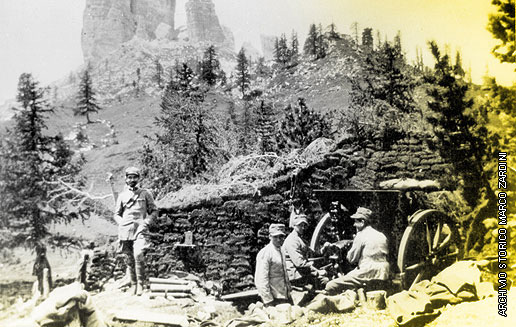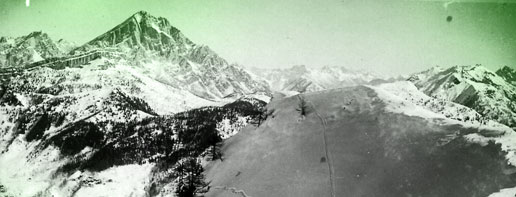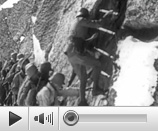You are here: HOME >> INTRODUCTION
Introduction
Bellunesi Dolomites
The front line of the Dolomites ran over impassable peaks and glaciers, from the Lagorai range to Marmolada, from Col di Lana to the Tofane mountains, from the Cristallo to the crests of Comelico. Such environment proved to be difficult for the soldiers lined up on both sides, most of them not being familiar with the dangers of the mountains.
The men were catapulted up there at the outbreak of war between Austria and Italy in late May 1915, into a hostile environment of snowstorms and glacial temperatures, under threat of avalanches, and they remained there until the defeat at Caporetto in October 1917.
In those two and half years they lived through incredible experiences: construction of the “city of ice” in Marmolada; the war of landmines, which mountain tops were on Col di Lana, Lagazuoi and Castelletto, where they exploded the mountain tops; “white death” under the snow. We can scarcely imagine the psychological state of disorientation and loneliness of these soldiers assigned to “battle work”, forced to live among the Dolomite rocks in summer and winter under enemy fire.
 Even the civilians near the front were victims of the war: whole villages were evacuated and destroyed, the population was displaced and people lived as refugees for years. Everything had to be rebuilt when they returned.
The Caporetto offensive of October 1917 caused the Italian army to retreat to the Monte Grappa massif and the Piave; the front was stabilized at this new line, abandoning the Dolomites.
Even the civilians near the front were victims of the war: whole villages were evacuated and destroyed, the population was displaced and people lived as refugees for years. Everything had to be rebuilt when they returned.
The Caporetto offensive of October 1917 caused the Italian army to retreat to the Monte Grappa massif and the Piave; the front was stabilized at this new line, abandoning the Dolomites.
As the front pulled back to the south, the Austro-German forces occupied and exploited the areas of Agordo, Cadore, Belluno and Feltre: the terrible "year of hunger" began for the people, whose resources were used to feed the invading army, which had now reached its limit. Indeed, the disintegration of the Austro-Hungarian Empire was near. The armistice signed on November 3rd at Villa Giusti ended the conflict, leading to the withdrawal of the armies and to Italy's annexation of the three municipalities of Livinallongo, Colle S. Lucia and Ampezzo, which had been Austrian territory until then.
 At the end of the war, the area of the Dolomites front was strewn with crosses; thousands were killed, wounded and taken prisoner, with devastation everywhere. Official postwar rhetoric long tried to make people forget, or at least to reduce the extent of the massacre.
At the end of the war, the area of the Dolomites front was strewn with crosses; thousands were killed, wounded and taken prisoner, with devastation everywhere. Official postwar rhetoric long tried to make people forget, or at least to reduce the extent of the massacre.
Today the historic reconstruction of the full panorama of the war's drama helps us reappraise these places, and plan the creation of a true culture of peace.
In those two and half years they lived through incredible experiences: construction of the “city of ice” in Marmolada; the war of landmines, which mountain tops were on Col di Lana, Lagazuoi and Castelletto, where they exploded the mountain tops; “white death” under the snow. We can scarcely imagine the psychological state of disorientation and loneliness of these soldiers assigned to “battle work”, forced to live among the Dolomite rocks in summer and winter under enemy fire.

As the front pulled back to the south, the Austro-German forces occupied and exploited the areas of Agordo, Cadore, Belluno and Feltre: the terrible "year of hunger" began for the people, whose resources were used to feed the invading army, which had now reached its limit. Indeed, the disintegration of the Austro-Hungarian Empire was near. The armistice signed on November 3rd at Villa Giusti ended the conflict, leading to the withdrawal of the armies and to Italy's annexation of the three municipalities of Livinallongo, Colle S. Lucia and Ampezzo, which had been Austrian territory until then.

Today the historic reconstruction of the full panorama of the war's drama helps us reappraise these places, and plan the creation of a true culture of peace.
Copyright 2010 - Regione del Veneto - Site Map




 top
top info
info print
print